
Hornbeams are hardwood trees in the plant genus Carpinus in the family Betulaceae. The 30–40 species occur across much of the temperate regions of the Northern Hemisphere.

Carpinus betulus, the European or common hornbeam, is a species of tree in the birch family Betulaceae, native to Western Asia and central, eastern, and southern Europe, including southern England. It requires a warm climate for good growth, and occurs only at elevations up to 1,000 metres (3,281 ft). It grows in mixed stands with oak, and in some areas beech, and is also a common tree in scree forests. Hornbeam was also known as yoke elm.

Eriocraniidae is a family of moths restricted to the Holarctic region, with six extant genera. These small, metallic moths are usually day-flying, emerging fairly early in the northern temperate spring. They have a proboscis with which they drink water or sap. The larvae are leaf miners on Fagales, principally the trees birch (Betula) and oak (Quercus), but a few on Salicales and Rosales.

Eriocrania semipurpurella is a moth of the family Eriocraniidae, found from Europe to Japan and in North America. It was first described by James Francis Stephens in 1835. The species closely resembles Eriocrania sangii and the larvae of both species mine the leaves of birch.
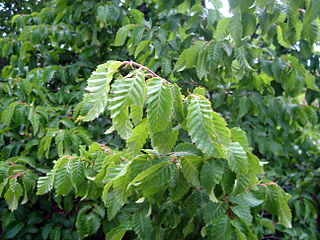
Carpinus orientalis, known as the Oriental hornbeam, is a hornbeam native to Hungary, the Balkans, Italy, Crimea, Turkey, Iran, and the Caucasus. and occurs usually on hot dry sites at lower altitudes in comparison to the Carpinus betulus.

Eriocrania sangii, the large birch purple, is a moth of the family Eriocraniidae found in Europe and described by John Henry Wood in 1891. The moth can be found flying in sunshine around birch trees and the larvae feed on birch leaves.
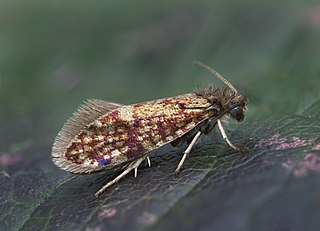
Eriocrania cicatricella is a moth of the family Eriocraniidae found in Europe. It was first described by Johan Wilhelm Zetterstedt in 1839. The larvae mine the leaves of birch.

Eriocrania salopiella is a moth of the family Eriocraniidae and is found in Europe. It was described by the English entomologist, Henry Tibbats Stainton in 1854. The larvae mine the leaves of birch.

Eriocrania sparrmannella also known as the mottled purple is a moth of the family Eriocraniidae, found in Europe and Japan. It was first described by the French entomologist, Louis Augustin Guillaume Bosc in 1791. The specific name honours the Swedish naturalist Anders Erikson Sparrman. The larvae mine the leaves of birch.

Eriocrania unimaculella is a moth of the family Eriocraniidae found in Europe. It was first described by the Swedish naturalist Johan Wilhelm Zetterstedt in 1839. The larvae feed inside the leaves of birch, making a mine.

Eriocrania chrysolepidella is a moth of the family Eriocraniidae found in Europe. It was first described by the German entomologist, Philipp Christoph Zeller in 1851. The larvae mine the leaves of hazel and hornbeam.
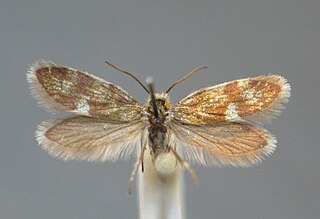
Eriocrania alpinella is a moth of the family Eriocraniidae, found in Central Europe, including Austria and Switzerland and possibly neighbouring countries.

Eriocrania is a Palearctic genus of moth of the family Eriocraniidae. The moths are diurnal, flying in sunshine, and the larvae are leaf miners, forming blotches in leaves.
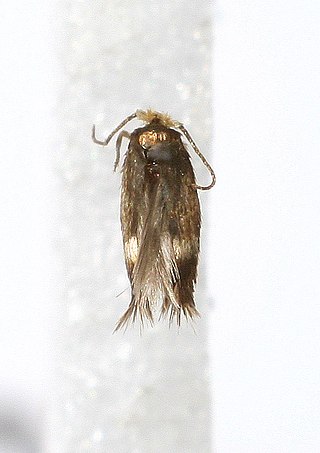
Stigmella microtheriella is a moth of the family Nepticulidae, found in Asia, Europe and New Zealand. The larvae mine the leaves of hazel and hornbeams. It was described by the English entomologist, Henry Tibbats Stainton in 1854 from a type specimen found in England.

Carpinus japonica, the Japanese hornbeam, is a hornbeam endemic to Japan but cultivated elsewhere as an ornamental.
Eriocrania breviapex is a moth of the family Eriocraniidae. It is found in the Cayuga Lake Basin of north-western New York.
Eriocrania komaii is a moth of the family Eriocraniidae. It is endemic to Japan (Honshu).
Eriocrania sakhalinella is a moth of the family Eriocraniidae. It was described, in 1983 by Mikhail Vasilievich Kozlov, from a specimen found on Sakhalin Island, Russia. It is also found in Japan.
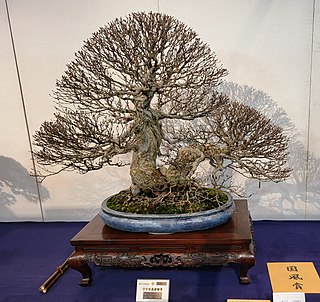
Carpinus turczaninovii, the Turczaninow hornbeam or Korean hornbeam, is a species of flowering plant in the family Betulaceae, native to central China, the Korean Peninsula, and central and southern Japan. It is a large shrub or small tree typically 15 to 20 ft tall and about 75% as wide, and is hardy to USDA zone 5b. It is available from commercial suppliers, and can handle very hard pruning.













